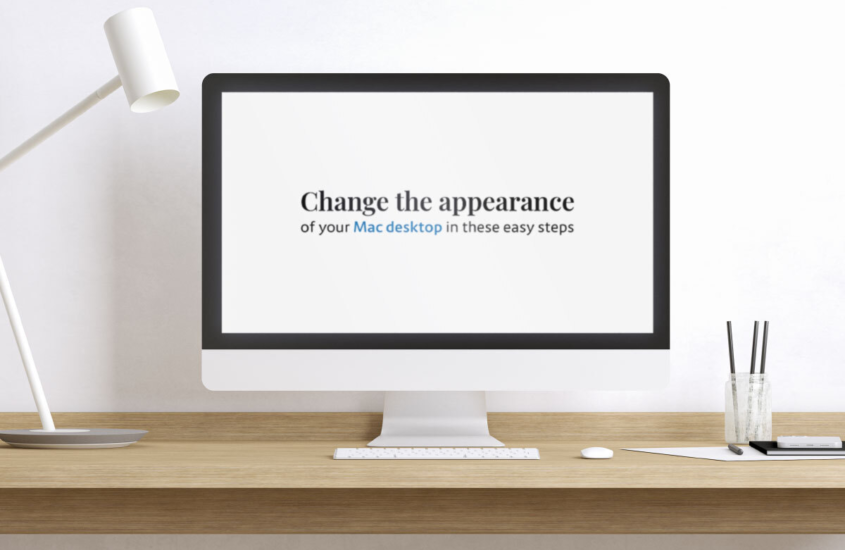Change the Appearance of Your Mac Desktop in These Easy Steps

Your Mac desktop doesn’t have to look the same. You can change the appearance by modifying a few items on the screen and tweaking some features. If this is what you’ve been waiting for since you brought home a MacBook, don’t waste time scrolling down and know the easy steps to personalize your Mac desktop.
Change the Background and Screensaver
No need to stay stuck with a boring desktop wallpaper and screensaver. Since the introduction of macOS Mojave, Mac desktop backgrounds have become dynamic and lively. You can opt for the background to automatically adapt itself according to the exact hour of the day. Furthermore, you don’t have to use the default system wallpapers. It is easy to spice things up by downloading unique wallpapers from Google or choosing to use vacation or birthday photos from your Photos Library.
To know how to change wallpaper and screensaver on your Mac, click https://setapp.com/how-to/change-desktop-background-and-screensaver-on-mac.
Personalize the Interface
The MacBook’s interface is user-friendly, and even if you are switching from Windows, you will quickly get the hang of using your new device. Along with being easy to use, Apple allows users to make modest visual personalizations to the interface, and these options are found in the System Preferences app. Go to the System Preferences > click the General tab > click the first three dropdowns on the screen to set the menus, buttons, and windows in graphite or blue; you can highlight them as well by selecting any of nine preset colors or choosing any color on the color wheel > change the sidebar icons in Finder as large, medium or small.
Additionally, you can change the theme of your desktop. The dark mode theme is available on Macs, and you can enable this theme to make it easier to work during the night.
For a smarter desktop appearance, you can choose to hide and reappear the menu bar automatically. When the menu bar is hidden, you’ll have more screen space, and the desktop will not appear cluttered.
In System Preferences, you can mitigate the flat look of macOS by clicking the Accessibility option and choosing Display on the left. You can tick the box next to Reduce Transparency so that translucent window backgrounds are turned off, or you can tick next to the Increase Contrast box to add thin borders to toolbars and windows.
Customize Folders and Icons
It is quick and easy to customize the spacing and size of desktop icons. Right-click in a blank spot > choose Show View > select Icon Size and Grid Spacing. While the change seems minor, it can significantly transform the way your Mac desktop looks.
Users can also change the way they can view items on the desktop. There are four view modes within a Finder window, and you can select list, icon, CoverFlow, or column view mode. Right-click in a blank spot > choose Show View options and change how files and folders are viewed on the screen.
That’s not all. Mac allows users to change the appearance of the folders. Every folder can have a unique look and can be configured into one folder. The folder icons can be customized, and users can use their images or download icons from the web. Once you have found the replacement icon, download it to your device. Then, double-click the picture to open it or open the icon using Preview. You must select all by pressing Command + A or Edit > Select All and copy it by pressing Command + C. Close Preview and choose the folder or file whose icon you wish to replace. You have to press Alt + Command + I to bring up the info window. Click on the small icon and press Command + V to paste the new icon.
You can revert to the default icon by repeating the steps to view the Inspector window. You must tap the Delete or Backspace key to the default folder or app icon.
Change up the Dock
One of the most functional aspects of Macs is the Dock. Therefore, you must take your time to personalize the Dock, so it works for you. First, you can remove the icons that are not useful by clicking one and dragging them out of the Dock. Then, release the icon when the Remove label appears.
Second, you can add items to the Dock by clicking and dragging the items from a folder like Utilities or Applications. You can also right-click on an app that you are currently using and select Options > Keep in Dock.
The Bottom Line
Changing the appearance of your Mac desktop is not rocket science. It can be done easily if you make small changes and tweaks. Some of the methods are mentioned above. Start with these, and then you can experiment as you become a pro at using your Mac system.




No Comments